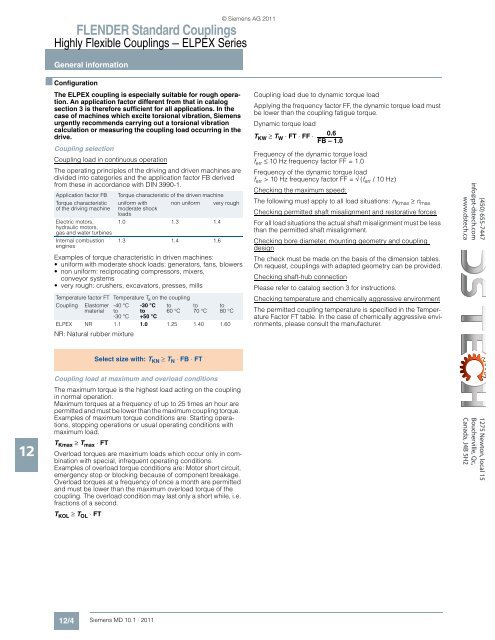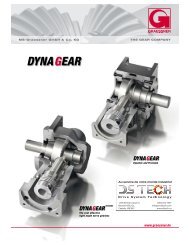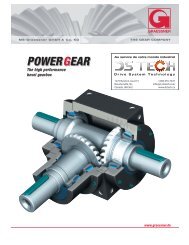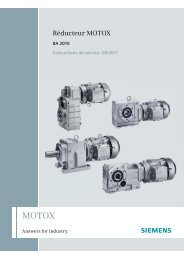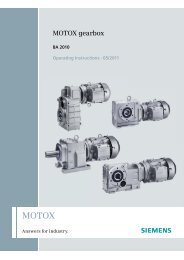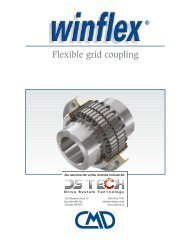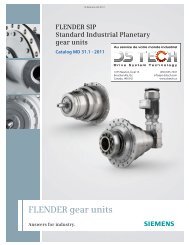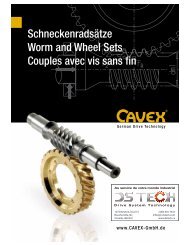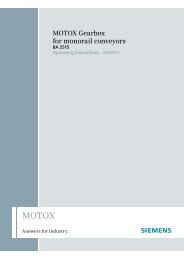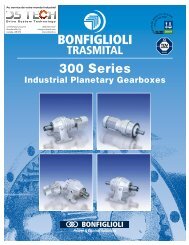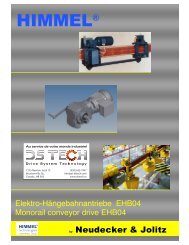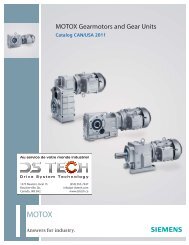FLENDER Standard Couplings - DS TECH
FLENDER Standard Couplings - DS TECH
FLENDER Standard Couplings - DS TECH
- No tags were found...
You also want an ePaper? Increase the reach of your titles
YUMPU automatically turns print PDFs into web optimized ePapers that Google loves.
<strong>FLENDER</strong> <strong>Standard</strong> <strong>Couplings</strong><br />
Highly Flexible <strong>Couplings</strong> — ELPEX Series<br />
© Siemens AG 2011<br />
General information<br />
■ Configuration<br />
The ELPEX coupling is especially suitable for rough operation.<br />
An application factor different from that in catalog<br />
section 3 is therefore sufficient for all applications. In the<br />
case of machines which excite torsional vibration, Siemens<br />
urgently recommends carrying out a torsional vibration<br />
calculation or measuring the coupling load occurring in the<br />
drive.<br />
Coupling selection<br />
Coupling load in continuous operation<br />
The operating principles of the driving and driven machines are<br />
divided into categories and the application factor FB derived<br />
from these in accordance with DIN 3990-1.<br />
Application factor FB<br />
Torque characteristic<br />
of the driving machine<br />
Electric motors,<br />
hydraulic motors,<br />
gas and water turbines<br />
Internal combustion<br />
engines<br />
Examples of torque characteristic in driven machines:<br />
• uniform with moderate shock loads: generators, fans, blowers<br />
• non uniform: reciprocating compressors, mixers,<br />
conveyor systems<br />
• very rough: crushers, excavators, presses, mills<br />
NR: Natural rubber mixture<br />
Torque characteristic of the driven machine<br />
uniform with non uniform very rough<br />
moderate shock<br />
loads<br />
1.0 1.3 1.4<br />
1.3 1.4 1.6<br />
Temperature factor FT Temperature T a on the coupling<br />
Coupling Elastomer<br />
material<br />
to<br />
60 °C<br />
-40 °C<br />
to<br />
-30 °C<br />
-30 °C<br />
to<br />
+50 °C<br />
to<br />
70 °C<br />
to<br />
80 °C<br />
ELPEX NR 1.1 1.0 1.25 1.40 1.60<br />
Coupling load due to dynamic torque load<br />
Applying the frequency factor FF, the dynamic torque load must<br />
be lower than the coupling fatigue torque.<br />
Dynamic torque load<br />
T KW ≥ T W ⋅ FT ⋅ FF ⋅<br />
0.6<br />
FB – 1.0<br />
Frequency of the dynamic torque load<br />
f err ≤ 10 Hz frequency factor FF = 1.0<br />
Frequency of the dynamic torque load<br />
f err >10Hz frequency factor FF=√ (f err /10Hz)<br />
Checking the maximum speed:<br />
The following must apply to all load situations: n Kmax ≥ n max<br />
Checking permitted shaft misalignment and restorative forces<br />
For all load situations the actual shaft misalignment must be less<br />
than the permitted shaft misalignment.<br />
Checking bore diameter, mounting geometry and coupling<br />
design<br />
The check must be made on the basis of the dimension tables.<br />
On request, couplings with adapted geometry can be provided.<br />
Checking shaft-hub connection<br />
Please refer to catalog section 3 for instructions.<br />
Checking temperature and chemically aggressive environment<br />
The permitted coupling temperature is specified in the Temperature<br />
Factor FT table. In the case of chemically aggressive environments,<br />
please consult the manufacturer.<br />
(450) 655-7447<br />
info@pt-dstech.com<br />
www.dstech.ca<br />
Select size with: T KN ≥ T N ⋅ FB ⋅ FT<br />
Coupling load at maximum and overload conditions<br />
12<br />
The maximum torque is the highest load acting on the coupling<br />
in normal operation.<br />
Maximum torques at a frequency of up to 25 times an hour are<br />
permitted and must be lower than the maximum coupling torque.<br />
Examples of maximum torque conditions are: Starting operations,<br />
stopping operations or usual operating conditions with<br />
maximum load.<br />
T Kmax ≥ T max ⋅ FT<br />
Overload torques are maximum loads which occur only in combination<br />
with special, infrequent operating conditions.<br />
Examples of overload torque conditions are: Motor short circuit,<br />
emergency stop or blocking because of component breakage.<br />
Overload torques at a frequency of once a month are permitted<br />
and must be lower than the maximum overload torque of the<br />
coupling. The overload condition may last only a short while, i.e.<br />
fractions of a second.<br />
T KOL ≥ T OL ⋅ FT<br />
1275 Newton, local 15<br />
Boucherville, Qc,<br />
Canada, J4B 5H2<br />
12/4 Siemens MD 10.1 · 2011


